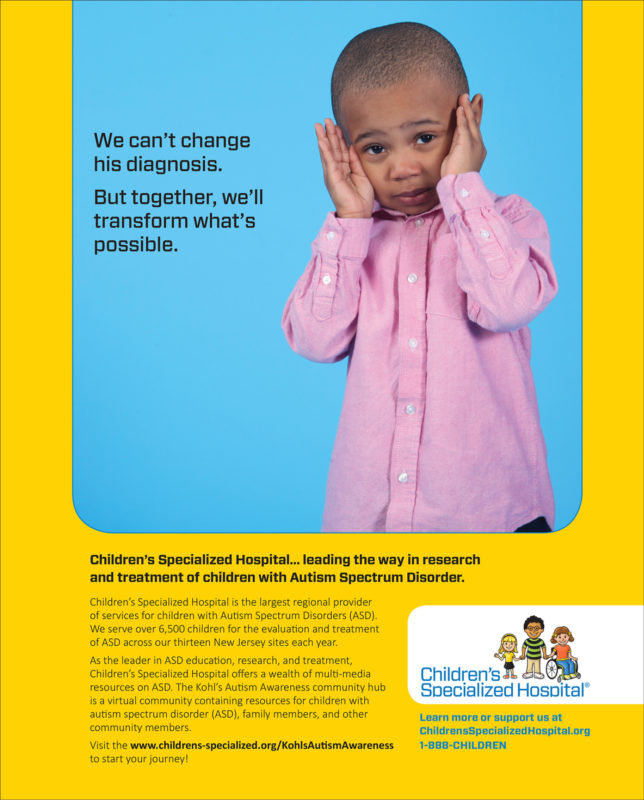Transition from adolescence to adulthood affects many areas of life including health, education and training, employment, living situation, and possibly guardianship. Autism spectrum disorder (ASD) presents unique diagnostic and medical management challenges throughout a person’s lifespan. As many youth with ASD have complex healthcare needs and face the cessation of many of the entitlements within the children’s system of services, the separation from a pediatric healthcare provider can often be challenging. Studies reveal 60% of transition-age youth with ASD have at least two health or mental health conditions in addition to ASD and 75% take at least one medication for medical or mental health issues.1 According to the 2009-10 National Survey of Children with Special Health Care Needs, the majority of youth with ASD have a primary care physician who treats only children1. Despite recommendations that transition preparation and discussion begin in early adolescence, the survey found this had not occurred for most youth with special health care needs.2

Marco will need to transition from pediatric care to adult care in the near future
Medical practices with formal policies on transition ensure all youth have access to the same transition services, the transition process is accomplished in a systematic way, and all members of the transition team (youth, family, and healthcare providers) have defined roles in the transition process. A primary care medical home team equipped to care for adolescents with ASD through their transition into adulthood can positively impact the transition experience and improve the lives of those involved.
This article describes a model program with tools to ensure seamless transition to adult healthcare for youth with ASD. Children’s Specialized Hospital’s pediatric Special Needs Primary Care (SNPC) has received National Committee for Quality Assurance (NCQA) recognition as a Patient-Centered Medical Home. In this setting, children with ASD and other complex conditions receive coordinated care. Aligning with medical home standards and guidelines, the SNPC team provides primary care as well as coordinates care with both external and internal sub-specialists. In 2015, Children’s Specialized received a grant from the New Jersey Governor’s Council for Medical Research and Treatment of Autism to create a medical home program for children and youth with ASD. The focus of this grant was creation of optimal care coordination practices. In 2016, a second grant was awarded by the Governor’s Council to specifically develop a structure to promote seamless transition into adult healthcare for youth with ASD within the medical home model. This Autism Medical Home Transition Collaborative© joins the hospital’s pediatric SNPC team, autism team, family faculty, and neurodevelopmental specialists with two Rutgers University affiliates: RWJ Family Medicine adult providers and The Boggs Center on Developmental Disabilities. Focusing on improving the evolution of care for individuals with ASD, this collaboration promotes improved care delivery to adolescents and young adults with ASD.
The Autism Medical Home Transition Collaborative has created an evidence-based, practical, and replicable healthcare Autism Transition Tool© encompassing many of the complexities of the ASD healthcare transition process. It provides timetabled reference sheets which identify topics for discussion, necessary skills, and supportive resources. Topic areas include primary care and wellness, dental care, specialty care, personal hygiene, nutrition, and fitness, behavioral health, sexuality and relationships, safety, education, healthcare provider choices, guardianship, adult service systems, and financial considerations. Additionally, the Autism Transition Tool will be used to support education delivery to the hospital community.
Within the Autism Transition Tool are a “Practice Level Checklist” and a “Patient Checklist.” The Practice Level Checklist prepares the pediatric practice for implementing a formal transition policy and process. This involves educating staff on the transition needs of youth with ASD, and specifically how these needs are addressed within the practice. It also includes the creation of an internal transition registry to ensure all adolescent patients within the practice receive appropriate transition care as outlined in the practice’s transition policy. This registry allows the practice to follow up with youth who have transitioned to adult services at a post-transition check-in.
The Patient Checklist is age specific and prompts the adolescent, family, and provider to complete items on their respective checklist in three age groupings: Stage One (12-13 years of age); Stage Two (14-16 years of age); and Stage Three (17-21 years of age). Included throughout the three stages of the Patient Checklist are psychosocial assessments inclusive of safety concerns, social skills, and activities for daily living; transition readiness activity; development of an autism medical passport summarizing the care plan and goals; assessment of health insurance status for adulthood; determination of need for guardianship; and addressing patient and family benefits (e.g. Supplemental Security Income, Social Security Disability Insurance, state disability services, special needs trust). Among the many resources within the Autism Transition Tool are tips for locating adult providers and questions to ask when interviewing a prospective adult provider.
One of the final activities of the Patient Checklist is a warm-handoff between the pediatric healthcare provider and the adult care provider prior to the patient’s first appointment with the adult care provider. Essentially, this discussion includes a review of the patient’s medical history, current plan of care, active issues, chronic conditions, likes and dislikes, goals, and typical length of appointment. While many elements of this discussion may be included in the autism medical passport, a simple conversation may facilitate a shared mental model and help provide seamless transition by ensuring both the pediatric and adult primary care providers have a shared understanding of the patient, his or her healthcare needs, and care preferences.
Lastly, the Patient Checklist includes a follow-up check-in with the patient and family post-transition as a close to the transition process. The dual benefits of this brief check-in are to ensure the adolescent has effectively transitioned and to provide an opportunity to evaluate any gaps in the practice’s transition process.
In the next phase of this grant, the hospital will implement the Autism Transition Tool into the SNPC and include within their Care NavigatorTM software program. Care Navigator is used as a primary communication and education tool facilitating shared care across departments and systems of care throughout a patient’s medical journey. The Care Navigator is designed to turn clinical and lifestyle quality data into actionable care planning and health promotion information in order to promote better health. The technology provides for continuous feedback, monitoring, and interaction among patients, family members, physicians, and clinical support staff.
To build the capacity of the health care system to serve adults with ASD and related intellectual and developmental disabilities, the Autism Transition Tool will be made available for use by other healthcare providers who care for adolescents with ASD.
The hospital provides other tools and resources for youth with ASD and their families to support health, safety, and other areas of life. One tool is a mobile app “Healthier Me.” Created through Children’s Specialized Hospital’s Kohl’s Autism Awareness program, the app educates and reinforces activities which support good hygiene habits, healthy eating, watching out for food allergies, keeping active, and staying safe. The hospital also provides The Community Hub (www.childrens-specialized.org/kohlsautismawareness) as a centralized online source of resources aimed at enhancing function and quality of life, increasing safety, and improving the effectiveness of community services.
For additional information about autism healthcare transition tools and other Children’s Specialized Hospital resources, please contact Aditi Doshi, project manager at ADoshi@childrens-specialized.org or visit www.childrens-specialized.org
Footnotes
1. Roux, Anne M., Shattuck, Paul T., Rast, Jessica E., Rava, Julianna A., and Anderson, Kristy, A. National Autism Indicators Report: Transition into Young Adulthood. Philadelphia, PA: Life Course Outcomes Research Program, A.J. Drexel Autism Institute, Drexel University, 2015.
2. McManus, M. A., Pollack, L. R., Cooley, W. C., McAllister, J. W., Lotstein, D., Strickland, B., & Mann, M. Y. (2013). Current status of transition preparation among youth with special needs in the United States. Pediatrics, peds-2012.





